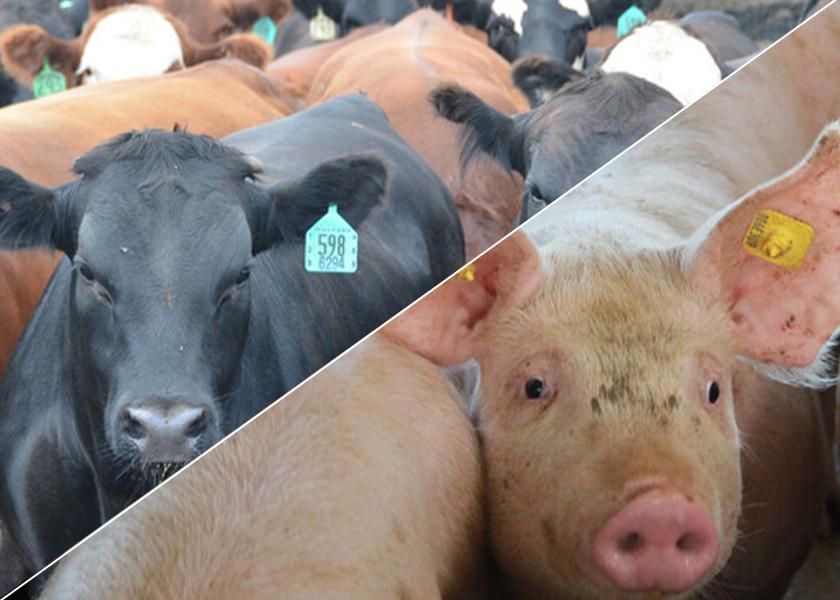Livestock Analysis | June 10, 2022

Price action: June lean hog futures rose 82.5 cents to $107.80. July hogs rose 47.5 cents to $105.475, down $5.275 for the week.
5-day outlook: Today’s tepid gains and July futures’ close near the weekly low will give the chart-based bears confidence to press prices lower early next week. Further pressure may stem from beliefs the cash market has peaked, as the CME lean hog index eroded the past two days following several weeks of firm advances. The preliminary index quote is $107.19, down 12 cents. The national direct five-day rolling average cash hog quote today is $115.94. Pork cutout values early today rose $2.50 to $111.59, led by solid gains in bellies. Movement at midday was 145.53 loads.
30-day outlook: Summer-month futures’ significant discounts to the cash hog index suggest the cash market has topped out on a near-term basis. Hog market bulls have been surprised and disappointed that pork cuts early in the grilling season have not seen better consumer demand amid high retail beef prices and record-high gasoline prices. A seasonal downturn in daily hog slaughter levels in the coming weeks may help to limit further downside price pressure in the cash and futures markets.
90-day outlook: Export demand remains a longer-term concern, in part due to sharply lower purchases from China. USDA Thursday reported weekly U.S. pork sales at 16,700 MT for 2022, down 48% from the previous week and down 44% from the prior four-week average. To keep a floor under the cash and futures markets, U.S. pork sales abroad need to show marked improvement. Today’s strong surge in the U.S. dollar index to a three-week high will not help U.S. pork better compete on the world trade market.
What to do: Be prepared to extend feed coverage on price weakness.
Hedgers: Carry all risk in the cash market for now.
Feed needs: You should have all corn-for-feed needs covered through mid-June. You are hand-to-mouth on soybean meal needs.
Price action: June live cattle fell 85 cents to $136.20, while August cattle dropped $1.10 cents to $136.20, up $2.35 for the week. August feeder futures tumbled $1.55 to $174.475.
5-day outlook: Cattle futures ended on a weak note despite bullish news from the cash and wholesale markets. The Monday-Thursday five-area average climbed to $140.52, a weekly rise of almost $2.50 from week-ago. Moreover, after slipping Thursday, choice beef cutout climbed 94 cents to $272.04, a post-Memorial Day high. This week’s cash average seems to rise a bit more as today’s trading is added to the four-day result, so today’s futures drop likely left the expiring June contract at $4.00-plus discount to cash with about three weeks left until expiration. That seemingly bodes well for next week's trading as grocers continue building beef inventories for planned Independence Day features. However, the underlying cause of today’s weakness, which almost surely arose from a major dive by the equity indexes and a concurrent jump in the value of the dollar, could extend into next week. Those suggest greater fears of a forthcoming recession and a drop in potential beef export demand.
30-day outlook: Look for grocers to continue buying beef actively until about June 22, which should bodes well for the cattle/beef complex. Wholesale prices will probably remain firm, though that won’t guarantee cash prices will also strengthen, though they seem likely to stabilize around $140.00. But the subsequent seasonal downturn, with greatly elevated retail costs amplifying the usual drop in summer beef demand, could prove substantial. Current feedlot marketings will tend to limit declines, but a cash market drop to the $130 area by mid-summer can’t be ruled out, especially if the equity markets tank and/or gasoline prices keep marching higher.
90-day outlook: We doubt cash prices will reach a summer low significantly below the $130.00 level due to the comparative tightness of market-ready fed cattle supplies. The size, length and sustainability of the subsequent seasonal rally is the big question going forward. The USDA is projecting much smaller U.S. beef supplies in the fourth quarter of 2022 and in first quarter of 2023, which is likely a big factor behind the increasingly large premiums built into futures for fall 2022 into spring 2023.
We’re skeptical over about a major slowdown in feedlot placements, which along with the cyclical decline in calf and yearling supplies and increased feed costs, are presumably the underlying reasons for the USDA’s low supply projections. But we believe feeder cattle prices will adjust downward if feed costs keep spiraling upward and the industry will find the needed supplies of young stuff to meet the demand, and don’t expect a substantial annual reduction in fall-winter feedlot supplies. The large futures premiums will incentivize aggressive feedlot placements in coming months and raise the risk of delayed marketings after Labor Day amid anticipation of a price surge. If that persists, it could eventually undercut the market and render the bullish forecasts self-defeating prophecies.
What to do: Be prepared to extend feed coverage on price weakness.
Hedgers: Carry all risk in the cash market for now.
Feed needs: You have all corn-for-feed needs covered in the cash market through mid-June. You are hand-to-mouth of soybean meal needs.






